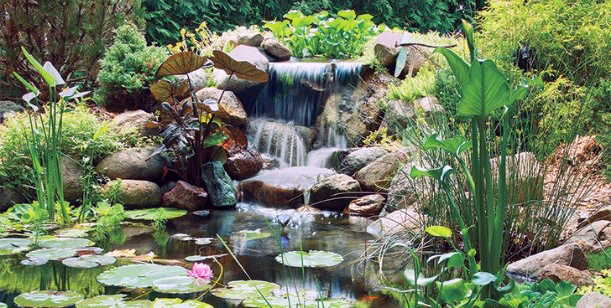Four Primary Pond Plants: Essential Choices
Types of Plants for Your Pond: Pond plants are a hearty food source to bugs, critters, and fish in and around the pond, but they also play an essential role in your pond’s filtration. They are the best filters known to man. The combination of plants and bacteria can clean up the most toxic waste man can product.
These are the 4 different types of plants that should be used in your water garden:
1. Submerged Pond Plants (seaweed or underwater plants) are a must for absorbing nutrients at the depths of your pond. It also provides; a place for eggs as fish spawn, hiding spots for fry, help in controlling water temperatures and in some cases, may even add a little oxygen to the water through photosynthesis.
- We recommend having 1 weighted bundle per 2 square feet of the pond’s surface area.
- For Example: If your pond’s surface is 8’ x 10’ you need 40 bundles. Math: 8x10=80 & 80/2=40
- As these submerged plants, like hornwort for example, absorb nutrients, they will grow. As it grows, it can be pinched off and re-bundled for added filtration.
Add submerged pond plants early in the spring, after the winter thaw, to help take up nutrient waste that has been sitting on the bottom of your pond all winter.

2. Water Lilies and Lotus are great plants for providing cover on the pond’s surface. Having a certain amount of coverage will help control water temps and provide security for your pond fish to swim freely around the pond.
- Water lilies and lotus typically sit deeper in the pond and the leaves grow up to, and open at or above the water’s surface.
- We recommend having 40-60%of the pond’s surface covered, or one plant for every 15-20 square feet.
- Surface coverage with plants will provide protection for pond fish from predators and add a shading effect for the water.
- Beware, too much coverage will turn into a “greenhouse” effect and warm the water instead.
- Water lilies and lotus both offer beautiful colors and textures with its flowers and leaves.
- Hardy water lilies and lotus will survive Ohio’s winter - when they are moved to lower levels of the pond in the fall. As long as the tubers do not freeze, 18” to 24” deep should be fine.
- Tropical water lilies come in very vibrant blues and purples that you will not see amongst hardy water lilies. Tropicals are more prolific bloomers and there are even night bloomers that open around 4 in the afternoon and stay open until 9 to 10 AM in the morning.

3. Marginal Pond Plants employ a plethora of job responsibilities in your water garden. They offer beauty, filtration, dimension, texture, food, protection, nesting and naturalization.
- Marginal pond plants prefer to be in the shallower water on a ledge along the pond’s edges - or in a bog area.
- We recommend having 25% of your perimeter planted with marginal pond plants.
- This percentage is to give you an idea on the quantity of plants you should use. They should be placed to give your pond beauty and the best filtration possible.
- As numerous as its benefits, so is the selection in variety of leaf textures, colors, heights and interest that marginals can bring to your pond!
- Some marginals will overwinter in your pond (hardy), while others may need to be brought inside (tropical) and treated like a house plant through the winter.
- If you are local, contact us about storing your tropical pond plants in our green house for the winter.

4. Floating Pond Plants, like water hyacinth and water lettuce, are tropical plants and should not go into your pond until the water temperature is between 65-70 degrees - and expected to stay there. Its roots dangle in the water from the surface, absorbing suspended nutrients as pond water flows by them. The roots also pose as a delightful snack for your finned friends.
- Floating pond plants reproduce rapidly and will need to be removed and/or relocated as they continue to grow.
- Use them with water lilies and lotus to help with surface coverage in your pond.
- If you have no more room in your pond, they make great compost - since they are filled with all that fish waste.
- Water hyacinth and lettuce may be placed in your waterfall spillway box, tucked into pockets of your stream or free floating on the surface of your pond.
- Feeder rings are a great way to keep your floating plants contained and out of your pond skimmer.
- Floating plants are considered as tropical plants and will need to be removed and thrown away, or composted in the fall to prevent decay in the pond releasing added waste into your pond water.

A perfectly planted pond will aid in keeping the eco-system balanced, water crystal clear, pond fish happy and healthy and provide you with your own little oasis. Did you know there are special planting zones for ponds? Read more about it here.
Discover all options for pond plants at Hoffman's Water X Scapes' garden center in Uniontown, Ohio. We have a wide variety of water lilies, lotus, marginals, floating and submerged pond plants.

